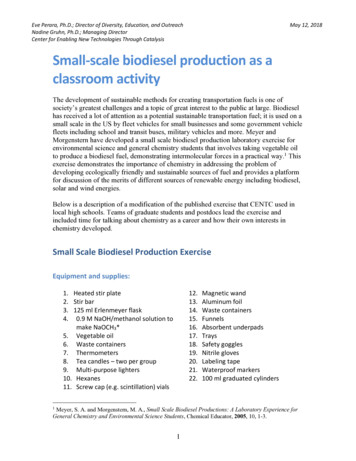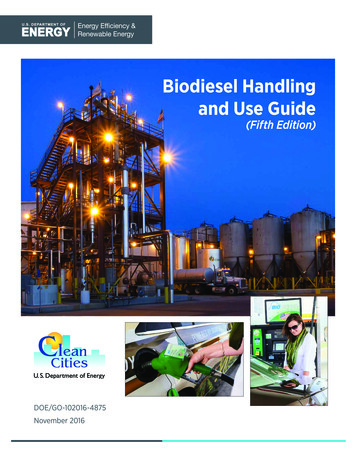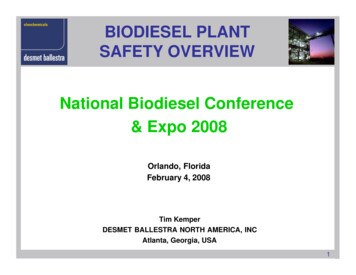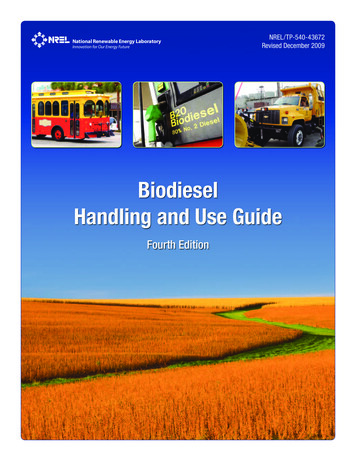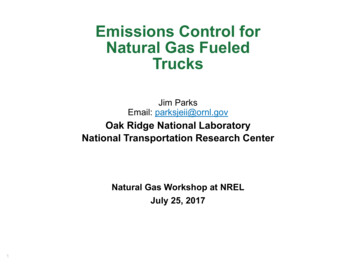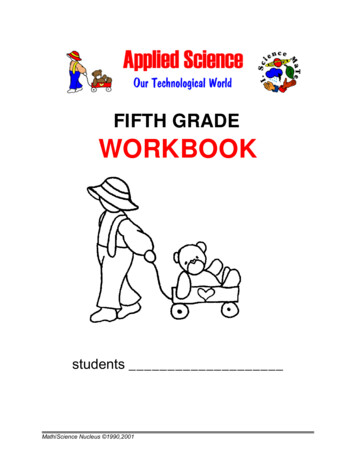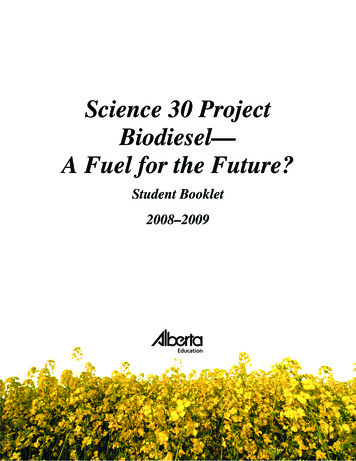
Transcription
Science 30 ProjectBiodiesel—A Fuel for the Future?Student Booklet2008–2009
Biodiesel—A Fuel for the Future?Table of ContentsPageProject Overview1Part 1: Making Biodiesel2Part 2: The Chemistry of Making Biodiesel9Part 3: Does Biodiesel Work in the Cold?11Part 4: A Risk–Benefit Analysis13Extension: Determining the Energy Content of Biodiesel14Copyright 2008, the Crown in Right of Alberta, as represented by the Minister of Education, AlbertaEducation, Learner Assessment, 44 Capital Boulevard, 10044 108 Street NW, Edmonton, Alberta T5J 5E6,and its licensors. All rights reserved.Special permission is granted to Alberta educators only to reproduce, for educational purposes and on anon-profit basis, parts of this document that do not contain excerpted material.
Project OverviewPrevious science courses probably taught you that molecules store chemical potentialenergy, which can be released when chemical bonds in matter are broken and new bondsare formed. Maybe you’ve even completed an experiment to determine the energy in asample of food or fuel. Whether oil is crude or plant-based — peanut oil, palm oil, oliveoil, or canola oil — it has molecules that are often described as “energy rich.”Rudolf Diesel, the inventor of the diesel engine, demonstrated in 1900 at the world’s fairin Paris that an engine could run on peanut oil rather than petroleum-based fuels.Considering the current concern over the depletion of crude oil reserves and the growingdemand for energy, Diesel was quite a visionary when mentioned, in 1912 thatEven though the use of vegetable oils for engine fuels may seeminsignificant today, such oils may become in the course of time asimportant as the petroleum and coal tar products of the present time.Diesel’s insight about the potential of plant-based oils as an energy source is beingdemonstrated by people using waste vegetable oil from restaurants as a fuel in theirdiesel-engine powered vehicles. Around the world, some governments and somecorporations within the energy industry are promoting the production of biodiesel, thefuel produced by the modification of vegetable oils.The yearly consumption of diesel fuel in North America is 245.5 billion litres, most ofit for transportation of goods and people. The production and sale of blended dieselfuels, which contain a percentage of biodiesel (e.g., 20% in the case of biodiesel B-20)mixed with petroleum-based diesel fuel, is a growing industry in Europe, where sourcesof petroleum-diesel are limited. Concerns about depleting petroleum sources elsewherein the world, including North America, have forced governments and the oil industry toconsider biodiesel as a means to offset some of the demand for petroleum-diesel.In this project, you will investigate the production and use of biodiesel, focusing on thechemistry of its production, the practicality of its use at low temperatures, the energychanges associated with its use, and the sustainability of this energy source.Science 30 ProjectPage Biodiesel—A Fuel for the Future?
Part 1: Making BiodieselBiodiesel is an alternative fuel that is made from vegetable and animal oils. It can beused directly in diesel vehicles or blended with traditional petroleum diesel. You willdiscover during this lab how easy it is to make and store biodiesel. The chemical reactionto produce biodiesel is as follows:Materials: lab balance (if using NaOH or KOH base in solid form)2 250 mL Erlenmeyer flasks and stoppers100 mL graduated cylinder50 mL graduated cylinderdisposable pipettes or a turkey basterthermometerwarm water bath (40–60 C)100 mL oil (a different oil for each group is best; possible oils are canola, olive,safflower, lard (warmed to liquid), strained deep fryer oil, grape seed, flaxseed,and sesame. Avoid nut oils because of potential allergies.) 20 mL methanolCautionary note: Flammable, dangerous fire risk, toxic by ingestion ONE of the following base solutions or solid base crystals: 15 mL of 1.0 mol/LNaOH(aq), 15 mL of 1.0 mol/L KOH(aq), 0.6 g of NaOH(s), 0.9 g of KOH(s)Cautionary note: NaOH and KOH solutions and solids are corrosive Safety goggles, gloves, and apronsSafety: You must wear goggles, gloves, and an apron. Methanol is flammable and poisonous. Dispose of excess methanol by allowingit to evaporate in a fume hood, or as directed by your teacher. The finished product should be stored in a sealed container and away from heatsources.Science 30 ProjectPage Biodiesel—A Fuel for the Future?
Procedure:Note: Biodiesel is made using three main components: oil, alcohol, and a base catalyst.This procedure provides a variety of alternative materials that you could useto produce the biodiesel. Your teacher will direct you to which materials you willbe using.Making Biodiesel:1.Measure out 100 mL of oil using a graduated cylinder, and pour the oil into one ofthe Erlenmeyer flasks.2.Record observations of colour, viscosity, clarity, and other aspects of theappearance of the starting material (oil).3.Check that the temperature of the water bath is between 40 C and 65 C. Place theErlenmeyer flask containing the oil sample into a water bath set up by your teacher.4.While your oil is warming, measure out 20 mL of methanol using a 50 mLgraduated cylinder and pour it into a second Erlenmeyer flask.5.To the Erlenmeyer flask containing the methanol, add ONE of the following:15 mL of 1.0 mol/L NaOH(aq) solution, 15 mL of KOH(aq) solution, 0.6 g ofNaOH(s), or 0.9 g of KOH(s). Swirl your mixture of methanol and base gentlyto mix. This mixture is called methoxide. If using a solid base, the mixture should be swirled or stirred until the solid basedissolves completely. To prevent evaporation, this mixture should be stoppered until it is ready to beadded to the oil.6.Pour the methoxide mixture into the warm oil in the Erlenmeyer flask.7.Stir, swirl, or stopper and gently shake the mixture for several minutes. Themixture will become cloudy and turn a milky colour. A stopper or aluminum foilcan be used on the flask to control fumes.8.If the reaction is successful, you should start seeing two layers developing insidethe flask. The heavier glycerin will start to settle to the bottom soon after you stopmixing the reactants. The biodiesel will be in the upper layer. The biodiesel variesin colour depending on the oil used. This will take at least an hour, but longer isbetter. The mixture should sit overnight to completely react.Science 30 ProjectPage Biodiesel—A Fuel for the Future?
Collecting Biodiesel (Best completed the next day):9.Use a disposable pipette or a turkey baster tocarefully remove the top layer, containing thebiodiesel, from the Erlenmeyer flask and moveit to a clean graduated cylinder.10.Record the volume of the biodiesel transferredfrom the Erlenmeyer flask in Table 1 on page 6.Biodiesel fromcanola oil (top layer)11. Record observations of colour, viscosity,clarity, and other aspects of the appearanceof the starting material (oil) and the product(biodiesel) collected in Table 2 on page 6.12. Place the biodiesel into an appropriatelylabelled container. Ensure that the contentsof the container are identified, and add anappropriate WHMIS label, your name, andtoday’s date.Glycerin(bottom layer)Note: This is crude biodiesel and is NOT of a high enoughqualityput directlyaSci30 08Proj tobiodieselmixtureintoCMYKvehicle. In industrial processes, it must go through a process called “washing” toremove excess glycerin, base, and alcohol.Science 30 ProjectPage Biodiesel—A Fuel for the Future?
Burning the Biodiesel (Your teacher may demonstrate this step):13. Biodiesel can be safely used in spirit burners. Pour some of your biodiesel into aspirit burner. Once the biodiesel has soaked up the wick, light the wick of the spiritburner. If the biodiesel does not soak up the wick, use the pipette to place a fewdrops on the wick. Record your observations in Table 3 on page 6.14. Try burning the unreacted oil and the methanol in other spirit burners. For eachdifferent fuel tested, record your observations in Table 3 on page 6.15. Store the remainder of the biodiesel in an appropriate container labelled with yourname. This may be used for Extension A of this project.Sci30 08 Proj biodiesel spirit burner CMYKScience 30 ProjectPage Biodiesel—A Fuel for the Future?
Data and Observations:Table 1: Quantitative Observations of ReactionVolume of oil (mL)Starting ReactantVolume of biodiesel (mL)ProductPercent yield of the reactionProduct% Yield Reactant 100Table 2: Qualitative Observations of ReactionObservations of Reactants(e.g., colour, smell, viscosity, etc.)Observations of Products(e.g., colour, smell, viscosity, etc.)Table 3: Qualitative Observations for Burning of FuelsType of Fuelin BurnerColour ofFlameDescriptionof tedvegetable oil oranimal fatMethanolScience 30 ProjectPage Biodiesel—A Fuel for the Future?
Conclusion and Evaluation:1.1Use the data from tables 2 and 3 on page 6 to qualitatively compare the products(biodiesel and glycerin) with the starting reactants (methanol and oil). . . . . . .1.2Evaluate the yield of biodiesel produced in the experiment. In commercialproduction of biodiesel, yields are often around 80% biodiesel. How does youryield compare to the commercial yield? If you used different types of oils, how didthe yields of the different oils compare?. . . . . . .1.3Calculate the cost to make 300 L of biodiesel using the following information.i.Methanol costs about 0.85/L and you need 0.2 L for every litre ofbiodiesel.ii.Lye (NaOH or KOH) can be bought at a hardware store for about 7/kg,and you will need about 1.4 kg for 300 L of oil.iii.Assume you can obtain waste oil for free from a local restaurant. . . . . . .Science 30 ProjectPage Biodiesel—A Fuel for the Future?
1.4Compare the cost of making biodiesel ( /L) with the cost of purchasing regulardiesel and/or gasoline at the pump ( /L) at current prices. . . . . .1.5Suggest modifications to the procedure and design of the experiment that wouldeither increase the amount of product from the process or improve the success oftesting the product. . . . . . .Scoring Guide for Skills Part 1: Making BiodieselScore4StandardofExcellenceScoring DescriptionsThe experiment is completed efficiently, with little or no extra guidancerequired. Detailed observations are made. Explicit references to datacollected are made when conclusions are drawn and modifications aredescribed.3The experiment is completed with some extra guidance required. Correctobservations and conclusions are made, and references to the data collectedare made when conclusions are drawn and modifications are described.2AcceptableStandardThe experiment is completed in a manner that enables the collectionof reasonably accurate data. Correct observations and reasonableconclusions are made. Limited reference to the data collected is made whenconclusions are drawn and modifications are described.1The experiment is completed using techniques that enable the collection ofonly limited and incomplete data. Incorrect observations and conclusionsare made, and vague references to data collected are made.0The performance is not at an appropriate level for a 30-level course.Science 30 ProjectPage Biodiesel—A Fuel for the Future?
Part 2: The Chemistry of Making BiodieselUse the following unbalanced chemical equation to answer the next four questions.Biodiesel ReactionPre-Activity Questions:2.1Identify the functional group found in the vegetable oil molecule. Circle it in theequation. .2.2State the name of the alcohol mixed with the vegetable oil in this reaction, and listsome of the properties of this alcohol or alcohols in general. . . .2.3 Explain what the “R” represents in the biodiesel chemical structure. .Activity:Using molecular model kits, marshmallows and toothpicks, or other materials,build a model that represents the reaction shown above. Your model shoulddemonstrate the following aspects of a chemical reaction: stoichiometric relationships (correct balancing of amount of substances, or eachtype of atom, involved in the process) differences in the chemical structures between reactants and products.Note: Use a single object in your model to represent “R.”Science 30 ProjectPage Biodiesel—A Fuel for the Future?
Use the following unbalanced chemical equation to answer the next question.Saponification (Soap-Making) Reaction2.4State the similarities and differences between the saponification reaction shownabove and the chemical reaction that produces biodiesel depicted in your model. . . . .Scoring Guide for Skills Part 2: The Chemistry of Making BiodieselScoreScoring Descriptions4StandardofExcellenceThe response is well organized and addresses all the major points of thequestion using appropriate and clear communication strategies. Thedescription of relevant scientific, technological, and/or societal concepts isexplicit. Descriptions and/or explanations of the interrelationships betweenthe concepts are correct and reflect a thorough understanding of thequestion.3The response is organized and addresses the major points of the questionusing appropriate communication strategies. The description of relevantscientific, technological, and/or societal concepts is evident. Descriptionsand/or explanations of the concepts are mostly correct and reflect a correctunderstanding of the question.2AcceptableStandardThe response is generally organized and addresses most of the major pointsof the question using adequate communication strategies. Descriptionsof relevant scientific, technological, and/or societal concepts are present.Descriptions of the concepts are generally correct and reflect an adequateunderstanding of the question.1The response is not well organized and addresses few of the major pointsof the question using inadequate communication strategies. Descriptions ofrelevant scientific, technological, and/or societal concepts are limited or notevident. Descriptions of the concepts are vague or lacking and reflect apoor understanding of the question.0The response does not address any of the major points of the question atan appropriate level for a 30-level course.Science 30 ProjectPage 10Biodiesel—A Fuel for the Future?
Part 3: Does Biodiesel Work in the Cold?Diesel engines differ from combustion engines in that they are lubricated by the fuelcombusted, not by oil added to the engine. A second difference is that a diesel enginestarts and stops with fuel in the system. A challenge for the designers of diesel engines isthe change in the properties of diesel fuel that occurs at lower temperatures: it becomesa thick and viscous gel. This property of diesel is of particular concern in Alberta wheretemperatures during winter can be extremely low.The viscosity of liquids can easily be compared using a 100 mL burette and a stopwatch.By measuring the time required for 100 mL of your fuel to flow from the stopcock ofthe burette, you can determine the viscosity of fuels. Another means of determiningviscosity, used commonly in the fuel industry, is to measure the fuel’s cloud point (thetemperature at which small, solid crystals first appear as the fuel is cooled). Determininga fuel’s cloud point is important because gelled or crystallized fuel will prevent the properoperation of a diesel engine.Analysis:3.1You are given the task of developing a diesel-fuel that must contain some biodieseland that must be acceptable for use in Alberta. Describe an experiment you wouldperform in order to determine the proportion of biodiesel/petrochemical diesel that would be mostacceptable for use in cold Alberta temperatures. state the manipulated, responding, and controlled variables for your experiment. . . . . . . . . . . . . . . .Science 30 ProjectPage 11Biodiesel—A Fuel for the Future?
. . . . . . . . . . . . . . . . . . . . .Scoring Guide for Skills Part 3: Does Biodiesel Work in the Cold?Score4StandardofExcellence3Scoring DescriptionsAn appropriate and practical experimental design is presented. The designof the overall study is based on a thorough understanding of the principlesof scientific inquiry.An appropriate and somewhat practical experimental design is presented.The design of the overall study is based on a correct understanding of theprinciples of scientific inquiry.2AcceptableStandardA generally appropriate or a practical procedure with some omissions orerrors is presented. The design of the overall study is based on a generallycorrect understanding of the principles of scientific inquiry.1An incomplete or an impractical procedure with major omissions orerrors is presented. The design of the overall study is based on a generallysuperficial understanding of the principles of scientific inquiry.0The response does not address any of the major points of the question atan appropriate level for a 30-level course.Science 30 ProjectPage 12Biodiesel—A Fuel for the Future?
Part 4: A Risk–Benefit AnalysisOur society is dependent on petroleum products for heat, electricity, and transportation.Unfortunately, petroleum is a limited and non-renewable resource. In addition, thesupply of petroleum products is not always reliable, resulting in fluctuating fuel prices.Researchers are searching for ways to supplement and/or replace petroleum fuels, andconsumers are looking for cheaper alternatives.Biodiesel is a fuel that has been proposed as either an alternative or as a means tosupplement petroleum-diesel or gasoline.Complete a risk–benefit analysis to answer the following question: Should theproduction and sale of biodiesel be promoted in Canada? Use the Internet and othertext sources as well as information you collected, analyzed, and evaluated while doingthis project to help you formulate your opinion.In preparing your analysis, consider a variety of issues including the following:reliability, safety, economic impact, environmental impact, accessibility of the resource,production potential, long-term viability as a resource, and other relevant issues.Supporting statements should be provided for all opinions and evaluations made.Present your risk–benefit analysis as a poster, PowerPoint presentation, or flowchart.Scoring Guide for Part 4: Risk–Benefit AnalysisScore4StandardofExcellence3Scoring DescriptionsThe response is well organized and addresses all the major points of thequestion using appropriate and clear communication strategies. Theinterrelationships between science, technology, and society are thoroughlyunderstood. Risks and benefits are thoroughly evaluated. Insightfuland convincing arguments are used to support a decision or judgment, anda range of viewpoints is considered.The response is organized and addresses the major points of the questionusing appropriate communication strategies. The interrelationships betweenscience, technology, and society are understood. Risks and benefits areevaluated. Clear and logical arguments are used to support a decision orjudgment, and alternative viewpoints are considered.2AcceptableStandardThe response is generally organized and addresses most of the majorpoints of the question using adequate communication strategies. Theinterrelationships between science, technology, and society are generallyunderstood. Risks and benefits are listed. Logical arguments are used tosupport a decision or judgment, and viewpoints are considered.1The response is not well organized and addresses few of the majorpoints of the question using inadequate communication strategies. Theinterrelationships between science, technology, and society are poorlyunderstood. Few risks and benefits are listed. Poorly formed argumentsare used to support a decision or judgment, and viewpoints are sketchy ornot provided.0The response does not address any of the major points of the question at anappropriate level for a 30-level course.Science 30 ProjectPage 13Biodiesel—A Fuel for the Future?
Extension: Determining the Energy Content of BiodieselPurpose:In this section of the lab, you will use the formula Q mc T, listed on page 5 of thedata booklet. Prepare a formatted spreadsheet that calculates the energy released by thevegetable oils used as reactant materials and compares it with the energy of the
chemistry of its production, the practicality of its use at low temperatures, the energy changes associated with its use, and the sustainability of this energy source. Science 30 Project Page 2
